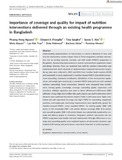| dc.contributor.author | Nguyen, Phuong Hong | |
| dc.contributor.author | Frongillo, Edward A. | |
| dc.contributor.author | Sanghvi, Tina | |
| dc.contributor.author | Kim, Sunny S. | |
| dc.contributor.author | Alayon, Silvia | |
| dc.contributor.author | Tran, Lan Mai | |
| dc.contributor.author | Mahmud, Zeba | |
| dc.contributor.author | Aktar, Bachera | |
| dc.contributor.author | Menon, Purnima | |
| dc.date.accessioned | 2022-03-06T04:36:40Z | |
| dc.date.available | 2022-03-06T04:36:40Z | |
| dc.date.copyright | 2018 | |
| dc.date.issued | 2018-10 | |
| dc.identifier.citation | Nguyen, P. H., Frongillo, E. A., Sanghvi, T., Kim, S. S., Alayon, S., Tran, L. M., Mahmud, Z., Aktar, B., & Menon, P. (2018). Importance of coverage and quality for impact of nutrition interventions delivered through an existing health programme in Bangladesh. Maternal & child nutrition, 14(4), e12613. https://doi.org/10.1111/mcn.12613 | en_US |
| dc.identifier.uri | http://hdl.handle.net/10361/16392 | |
| dc.description | This article was published in the Maternal & Child Nutrition [© 2018 The Authors. Maternal and Child Nutrition Published by John Wiley & Sons, Ltd. ] and the definite version is available at : https://doi.org/10.1111/mcn.12613 The Journal's website is at: https://onlinelibrary.wiley.com/doi/10.1111/mcn.12613 | en_US |
| dc.description.abstract | Understanding implementation of interventions is critical to illuminate if, how, and why the interventions achieve impact. Alive & Thrive integrated a nutrition intervention into an existing maternal, neonatal, and child health (MNCH) programme in Bangladesh, documenting improvements in women's micronutrient supplement intake and dietary diversity. Here, we examined how well the nutrition intervention was implemented and which elements of implementation explained intervention impact. Survey data were collected in 2015 and 2016 from frontline health workers (FLW) and households in areas randomized to nutrition‐focused MNCH (intensified interpersonal counselling, community mobilization, distribution of free micronutrient supplements, and weight‐gain monitoring) or standard MNCH (antenatal care with standard nutrition counselling). Seven intervention elements were measured: time commitment, training quality, knowledge, coverage, counselling quality, supervision, and incentives. Multiple regression was used to derive difference‐in‐differences (DID) estimates. Using village‐level endline data, path analysis was used to determine which elements most explained intervention impacts. FLWs in both areas were highly committed and well supervised. Coverage was high (>90%) for counselling, supplement provision, and weight‐gain monitoring. Improvements were significantly greater for nutrition‐focused MNCH, versus standard MNCH, for training quality (DID: 2.42 points of 10), knowledge (DID: 1.20 points), delivery coverage (DID: 4.16 points), and counselling quality (DID: 1.60 points). Impact was substantially explained by coverage and delivery quality. In conclusion, integration nutrition intervention into the MNCH programme was feasible and well‐implemented. Although differences in coverage and counselling quality most explained impacts, all intervention elements—particularly FLW training and performance—were likely important to achieving impact. | en_US |
| dc.language.iso | en_US | en_US |
| dc.publisher | Wiley Online Library | en_US |
| dc.relation.uri | https://onlinelibrary.wiley.com/doi/10.1111/mcn.12613 | |
| dc.subject | Bangladesh | en_US |
| dc.subject | Implementation | en_US |
| dc.subject | Maternal nutrition | en_US |
| dc.subject | Service delivery | en_US |
| dc.title | Importance of coverage and quality for impact of nutrition interventions delivered through an existing health programme in Bangladesh | en_US |
| dc.type | Journal Article | en_US |
| dc.description.version | Published | |
| dc.contributor.department | Brac James P. Grant School of Public Health | |
| dc.identifier.doi | https://doi.org/10.1111/mcn.12613 | |
| dc.relation.journal | Maternal & Child Nutrition Journal | |

